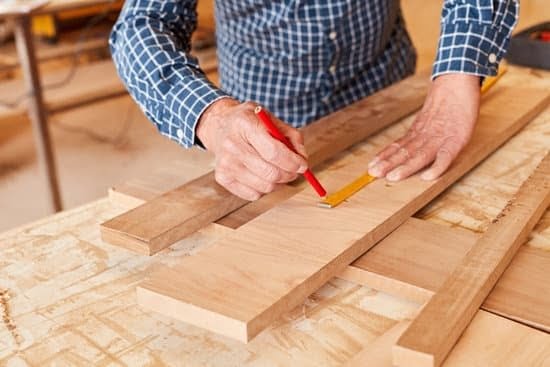Introduction to Drew Langsner and His Green Woodworking Craft
Drew Langsner is a world-renowned green woodworking craftsman, who has had over four decades of experience in the craft. During this time his knowledge and craftsmanship have reached legendary status amongst fellow woodworkers and artisans alike. His skill encompasses the influences of English country furniture traditions, traditional Scandinavian tools and techniques, Arts & Crafts joinery, rural americana craftsmen like Peter Voulkos and many more. Drew has established an innovative concept for greenwood crafts called “rounded work” which refers to working an entire rounded log without splitting it into boards first. He became widely known for his use of traditional hand tools in crafting functional furniture from locally sourced trees using a combination of sawing, shaving and burning techniques.
Draw’s philosophy for his work embodies his deep respect for nature and fosters sustainability by utilizing green wood as viably as possible; honoring the tree from where it was harvested to the point that it shows up on a customer’s doorsteps as furniture crafted with love. He believes each stem is unique and should be used wholly or partly before being discarded and with this philosophy he works with straight lines honouring the unique character of each piece while still producing pieces that fit perfectly together like puzzle pieces when Crafted well.
In addition to teaching workshops throughout North America at various schools, festivals, colleges and universities; he is also an accomplished author having written multiple books featured in five languages. Drew has been consulted extensively by timber framers, furniture makers and preservationists alike who seek out his guidance on projects ranging from playgrounds to museums which embody the qualities of this unique woodworking craft Drew so passionately teaches – Green Woodworking Craftsman.
Exploring the Craft of Green Woodworking
Green woodworking is woodworking that utilizes wet wood freshly cut from a tree or log. In contrast to other forms of woodworking, green woodworking does not require drying and planing of the lumber beforehand.
The processes used in green woodworking are often simpler than working with dry lumber and create furniture pieces or shapes which remain closer to the natural curves and properties of the original tree. It is believed by green woodworkers that the best natural shape of a piece can be brought out while working with it while these characteristics may be lost when using dry timber.
Green woodworking begins with harvesting fresh, wet timbers from logs. The logs are then either split down into planks for construction, or left incorporated and worked as a whole piece for artistic creations like spoons. Working with greenwood requires different tools than working with seasoned lumber; instead of saws, planes, chisels and more, simple tools such as axes, froes and drawknives are used to rough shape the woods. All pieces are created by hand instead of machines for an improved sense of connection between the crafter and workpiece.
After initial shaping has been completed, joints like mortise-and-tenon or English peg joinery are often coursed in to allow complex pieces to come together seamlessly as well as creating long lasting sturdiness despite its incredibly lightweight composition made possible by being cut greenly before seasoning. Cure times vary depending on size and environment but often take several months before taking that “seasoned” dry condition.
Green woodworking represents a traditional way of creating wooden furniture where passion overrides technicalities since no two pieces will ever be identical due to their organic nature – making each end product unique many techniques used in modern carpentry serve uninterruptible knowledge passed through generations stretching back centuries ago into a way of life through different cultures around the world
Benefits of Green Woodworking
Green woodworking is a woodworking technique that uses freshly cut, uncured and unseasoned wood to create pieces of furniture. Working with green wood offers several advantages over other woodworking techniques:
1. A more sustainable approach: Green woodworking encourages the use of naturally available materials such as green logs instead of processed and potentially hazardous lumber. This reduces the need for the transportation and purchase of processed material, reducing environmental impact.
2. Cost-effectiveness: Freshly cut green logs are often less expensive than stored and seasoned lumber, which can quickly become expensive due to transportation costs. Additionally, green logs can be grown or harvested locally, significantly cutting down on transportation costs while also providing jobs to local employees in harvesting processes; both aspects contribute to cost-efficiency benefits to this method of wood exploration.
3. Ease of Use: Easily combined with other carpentry techniques, working with green firewood is relatively simple considering one does not have to transport it long distances before use. Additionally, they don’t need to be cut or processed too much before starting work; their shape shortly after being cut from a tree allows for easier manipulation during building construction pieces of furniture, allowing any carpenter – from an amateur to an experienced professional – quick access into carpentry projects previously deemed difficult by them due to lack of expertise on how to begin working with cured woods.
Tools and Supplies Needed for Green Woodworking
Green woodworking refers to the practice of using freshly cut, unseasoned timber for carpentry projects. This type of woodworking requires a different set of tools than typical joinery and furniture building techniques used with dry woods. In green woodworking, you are focusing on traditional woodworking techniques such as steambending, shaping, and carving that would have been used generations ago.
In order to get started with green woodworking, it is important to have the right tools and materials. A basic toolkit should include:
• Adzes: These versatile tools are perfect for roughing out shapes and carving curves in your workpiece.
• Drawknives: A drawknife is a hand-held tool that can be used to remove large or small amounts of material from a workpiece in a short amount of time. It can be very useful in creating complex shapes quickly and precisely.
• Chisels: Whether you’re creating joinery or just forming detailed carvings, chisels are an essential part of any woodworker’s kit. Make sure to select appropriate chisel sizes so you have the precision needed for different tasks.
• Gouges: Just like chisels, gouges can come in many different sizes and shapes for various types of workpieces. They are typically used for more intricate details such as hollowing out surfaces and carving complex designs into surfaces.
• Mallets And Hammers: Using a mallet or hammer will help to drive chisels or gouges into your workpiece when needed. Keep multiple sizes handy depending on the jobs you plan on tackling.
• Planes Or Surforms: When working with greenwood, having either a plane or surform readily available will help smooth surfaces quickly before adding joins or putting on final touches like finishing oil or waxes into your project piece.
• Clamps And Vises: Having these tools available while working is extremely important since they provide extra support while joining pieces together so they stay secure while you’re working with them. Depending on your needs size-wise they could range from smaller F-style clamps to bespoke vise hardware with larger frames suitable for larger projects or heavier parts needing secured together tightly.
With all these essential items in hand, you’ll be able to tackle virtually any job safely and efficiently! As always, it is important to use proper safety gear and techniques when working with any type of power tool so that everyone remains safe during each step every time .
How to Approach a Green Woodworking Project
Green woodworking is a creative, sustainable approach to traditional woodworking which involves the use of freshly harvested wood while bypassing modern energy-intensive processes such as kiln-drying and machinery.
To get started with green woodworking, it’s essential to begin by surveying your available resources. These can include timber from windfall trees, reclaim or recycled lumber, or even newly milled lumber from a local sawmill. Once you have sourced your material you can then begin work on two key components of any woodworking project: preparation and joinery.
When preparing your green wood, the aim is to achieve an even balance of moisture throughout – seeking out areas that are exceptionally dry or damp and adjusting these manually with a damp cloth or an application of hot water (respectively). Now that your material is ready for shaping, you’ll need to employ one of the many different jointing skills available. Beginners may want to try simpler options such as half-lap joints (for box making) and mortise and tenon joints (natural chairmaking). To go further in joinery one should practice dovetailing and dovetail rabbet joints for more precision in making drawers.
Once you have completed shaping and joinery it’s time to decide whether to store your piece for a lengthy period – called seasoning – or receive immediate use out of it utilizing humidity control devices such as dehumidifiers or hygrometers. The final step would be the finishing techniques used to protect your pieces. This would involve highlighting certain sections with oil finishes while others could be polished (as seen with spoons).
Overall, when completing a green woodworking project it’s important to honor the hard work put into each part – every element within woods natural lifetime should be respected resulting in life-long durable furniture pieces as well as experience gained through traditional hand tools.
Why Drew Langsner Has Become a Leader in the Craft
Drew Langsner is a leader in the craft of green woodworking––a style of woodworking that keeps traditional methods alive by using no electricity or other power tools. The Appalachian-based carpenter has over 40 years of experience working with hand tools, and primarily makes furniture out of directly harvested greenwood. Among his most celebrated pieces is the Crotched Rocker, designed for comfort and stability. He is also credited for creating the first contemporary English Windsor chair made fully from green wood.
There are several reasons Drew Langsner has become an expert in this craft. He studied extensively at John C Harvey’s workshop in Pennsylvania, and later founded his own school of rural craftsmanship––the Country Workshops in Burnsville, North Carolina. In 1993 he published The Chairmaker’s Workshop: A Practical Guide to Handcrafting Windsor & Post-and-Rung Chairs, which is considered one of the best resources on the topic. He also continues to create innovative new pieces that advance green woodworking forward while respecting its history and traditions.
Beyond his own accomplishments as a craftsman, Drew Langsner has had a profound effect on the larger community devoted to green woodworking. His school provides hands-on woodworking experiences to budding makers; students learn how design with functionality, select and fell trees sustainably, steam bend wooden parts without specialized tools and equipment; join with pegged mortise and tenon joints, and many more skills that underpin traditional carpentry practices. Through his work as a teacher , researcher , author, and artisan , he has inspired others in the field to connect deeply with their surroundings by creating quality pieces that respect the ancient craftsmanship techniques .
Building Community and Resources for Green Woodworking
Makers interested in getting involved in green woodworking can access a variety of online and offline resources to get started on their journey. One easy way to start learning is by searching the web for basic information, online shops, tutorials, forums, and more. For example, many popular woodworking sites like WoodNet and LumberJocks offer plenty of articles, instructional materials, and forum discussions about green woodworking. Additionally, independent websites such as Drew Langsner’s Green Woodworking are great for finding detailed instructions for projects with enough detail to help even novice makers build complex pieces from scratch.
The green woodworking community is also an excellent source of knowledge and experience that makers can draw upon when looking for inspiration or guidance on project ideas. Facebook groups such as Traditional Green Woodworkers UK have over 3 thousand members who post photos of their work, share their tips and tricks, provide critiques of others’ pieces, trade tools/woodworking supplies and much more. There are also diverse regional green woodworking guilds (in North America) which not only provide workshops but can allow you to chat with veteran craftsmen in person. Attending craft fairs (or having your own booth!) is another great way to meet people with similar interests while growing a network.
Conclusion
Green woodworking is a type of woodworking championed by American Drew Langsner, whose life’s work has been dedicated to focusing on the benefits of using and utilizing green wood. With age-old knowledge and decades of experience, he has helped innumerable people all over the world to reap the rewards that come from greenwood working and carving. His technical expertise and understanding of the craft can be seen in many works and projects that he has produced himself. From furniture to artwork, his work is often exquisite and functional.
Throughout his career, Langsner has continually reinforced the notion that green woods are infinitely more useful than their dry counterparts, as they are more easily worked with hand tools and require much less time invested into preparing them before their use in projects. Not only are they easier to work with but they often contain unique grains and colors that cannot be found elsewhere. Ultimately, green woodworking with Drew Langsner is fundamentally different when compared to traditional methods due to its sustainability and focus on ensuring every growing tree is used as efficiently as possible.
In conclusion, Drew Langsner’s approach towards green woodworking has revolutionized how we think about working with timber for construction projects or any other purpose imaginable. By placing importance on using current trees responsibly over relying on store-bought lumber, he has allowed us to elevate our craftsmanship while keeping a deep respect for nature and its resources. We can rest easy knowing that through Drew Langsner’s dedication to sustainable forestry practices, future generations will continue benefit from his pioneering spirit for years to come.

Hi everyone! I’m a woodworker and blogger, and this is my woodworking blog. In my blog, I share tips and tricks for woodworkers of all skill levels, as well as project ideas that you can try yourself.





